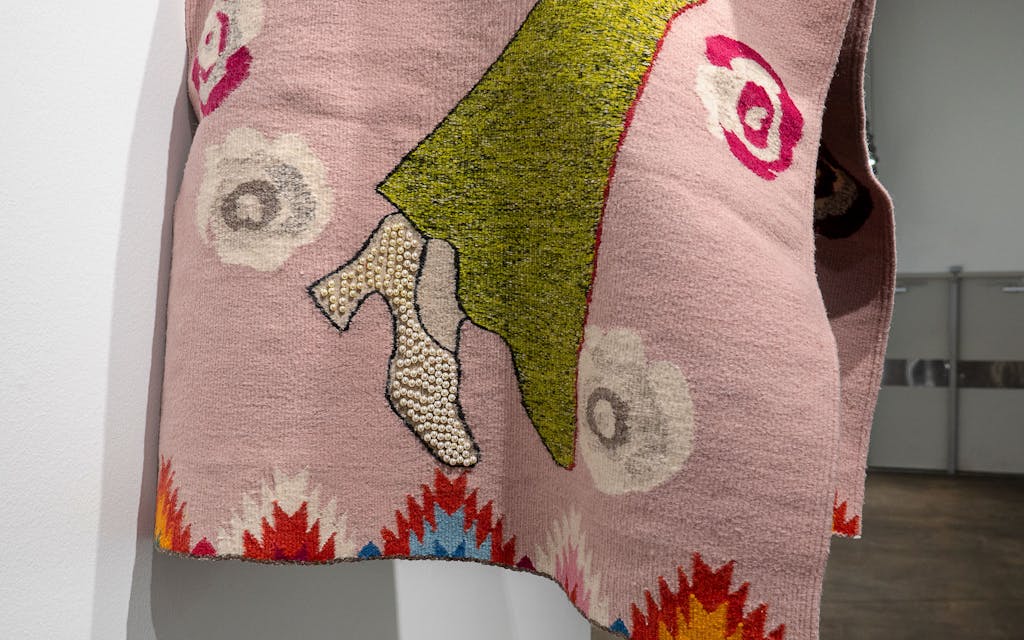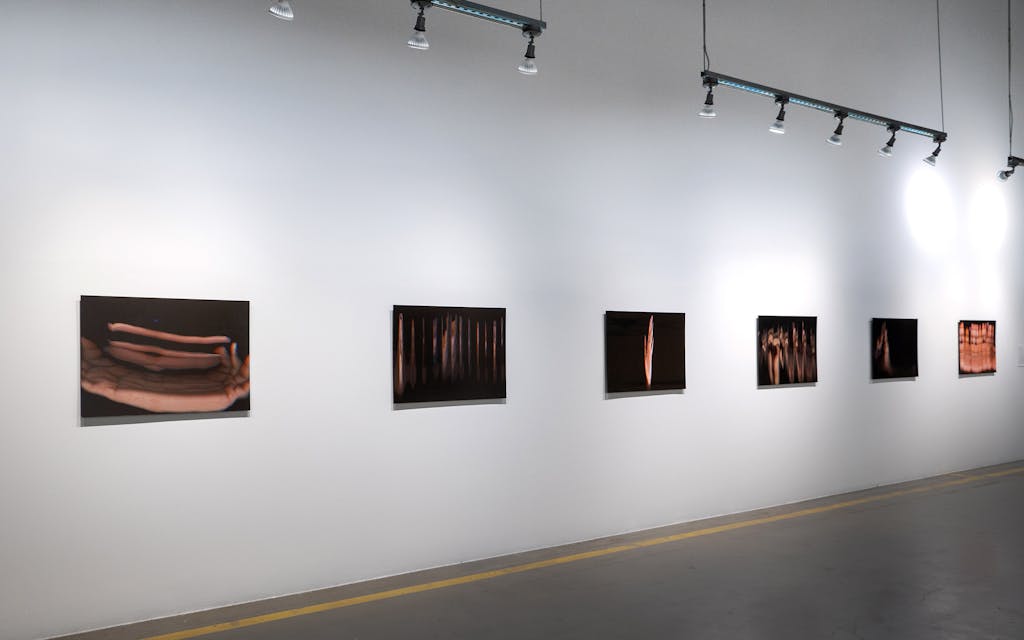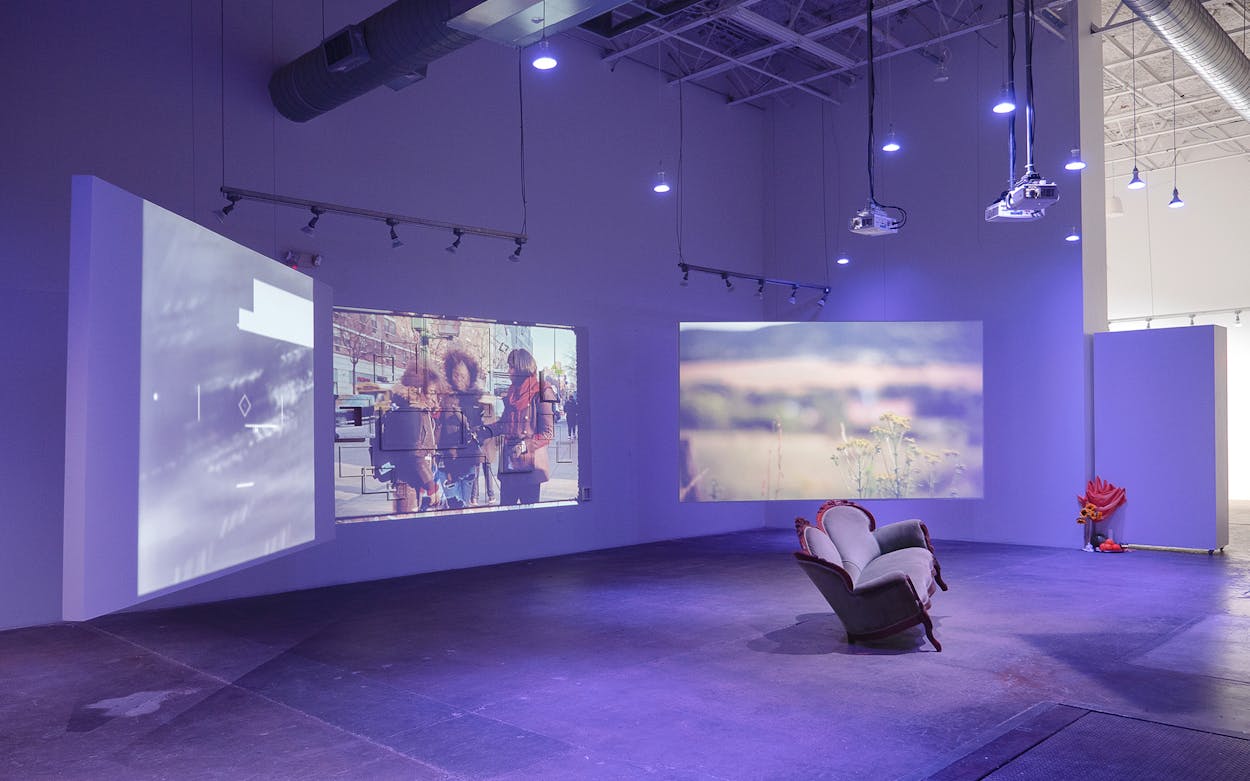I did not expect to be pondering Selena’s curvaceous butt at an art exhibition called “In Place of an Index.” But there it was—or at least its woven suggestion—atop four equestrian blanket–inspired sculptures by Travis Boyer that are affixed to a wall at Silver Street Studios in Houston. Designed by Boyer, who grew up in Fort Worth, the sculptures were expertly hand-woven in Oaxaca by Mariano Sosa Martinez; they’re also embellished with pearls, rhinestones, sequins, and fringe. Each one depicts the legs of the late, fashion-forward Tejano megastar in a different outfit, positioned as if she’s astride a horse (alluding to her final concert at the 1995 Houston Livestock Show and Rodeo). You have to imagine her top half—a poignant reminder of absence.
Standing before these playful, eye-catching sculptures, you can almost hear the sounds of “Como la Flor,” and yet the piece is wistful too, allowing viewers to ponder who Selena might’ve become. It’s an old story, told in an inventive new form. The same goes for the rest of the highly conceptual show, which features the work of twelve Texas artists who use or refer to “the archive” (art-speak for any source from the past—often paintings, documents, or vintage photographs and film footage) to invite new ways of considering historical narratives—particularly those that perpetuate racial, ethnic, and gender biases. Not that you have to overthink it. This show has a big heart, full of poetic, urgent personal expressions of corporeal existence in a universe where time doesn’t stand still.

One of five exhibitions in the 2021 Texas Biennial, “In Place of an Index” is hosted by FotoFest, a Houston nonprofit focused on photography and new media. It’s fitting, then, that the free exhibit, which will be on view through November 13, also focuses on works that involve the use of photographs or cinematography. That still leaves plenty of room for other media, including sculpture, textiles, collage, and prints on such materials as crinkly silver Mylar, billboard-scale vinyl, and small patches of tattooed “skin” made of synthetic rubber.
Ryan N. Dennis and Evan Garza, who cocurated the biennial’s other four exhibitions in San Antonio, teamed up at Silver Street with FotoFest associate curator Max Fields. (The biennial is produced by Austin’s Big Medium.) The artists are mostly in their thirties and forties, with national and international credentials. Most of the works are new or newly reconfigured, and several were commissioned specifically for the show.
“In Place of an Index” is grounded in questions about bodies of color that begin with The Giverny Suite, a three-channel film installation by Dallas native Ja’Tovia Gary that some critics have called a defining work of the decade. The space’s furnishings evoke a parlor of disrupted memories. A broken-legged, antique settee sits at the center, in front of a white projection wall hung with empty picture frames. The Giverny Suite occupies the show’s only enclosed gallery space, and a pair of small altars flanking the doorway could be a gesture of respect to opposing forces of nature. One looks like an offering to the sun, the other to the moon.
In the film projected on the back wall, Gary interviews other Black women on a Harlem street, asking, “Do you feel safe in your body?” Some don’t, but some do. And viewers feel the conflicted energy as Gary juxtaposes those documentary moments with archival film clips of civil rights activists Josephine Baker, Nina Simone, and Fred Hampton; footage from drone strikes and police shootings; and scenes shot during Gary’s residency at Claude Monet’s lush French garden. I was appalled by the sight of Baker as a flamboyantly caged bird in the showy finale of the 1934 film Zouzou, even as I admired how she owns the role and wondered about the irony of her glamorous white costume; just as I was unmoored by Simone’s seething and steely (but pained) look as she talk-sings “Feelings.”
The rest of the show is displayed throughout Silver Street’s broad hallways, interrupted by doors that open to private studios. Intimate, framed works can get lost there. Still, Kara Springer’s Death Defying Feats & Everyday Abstractions creates a palpable emotional charge for those willing to read the story of painful survival typed underneath seven inkjet prints. Each bears the same image of the exhausted artist after a precarious childbirth, on a sofa with her newborn baby. Springer often repeats identical images to encourage viewers to look more deeply. The large prints of her Ten Days Before Freedom, A Hymnal cast a meditative spell with their recurring images of ghostly, weather-worn tents at a site in the Bahamas that has a story akin to that of Texas’s Juneteenth holiday.

Houston-raised artist Regina Agu shows her hand—literally—in a series of six inkjet prints that mesmerize with their sense of motion and rich brown-on-black tones. It took me a few minutes to decipher the source of her abstracted imagery: she’s made flatbed photo-scanner images of her hands as she performs gestures gleaned from historical depictions and found photos of Black figures. The titles add another interesting layer. They were written by an alt-text generator, an artificial-intelligence tool that plainly describes what it “sees”—as in, “A picture containing person,” or “A picture containing small, sitting, white, table.” (Go figure.)
Houston-raised Autumn Knight’s new Meesh Suite Polaroids deserve a close look for a different take on this theme. She’s known more as a performance artist—“Look! Objects!” cocurator Fields said as he drew my attention there. Knight has made small, black and white images of her hands and feet that echo her 2017 video Meesh, in which she retraces the steps of former first lady Michelle Obama up the stairwell of a crumbling building. (The video is also on view.)
Ryan Hawk, also from Houston, bravely examines the awkwardness of being empathetically white in the woke world. His compelling impossible erasures (of the impossible) #6 made me squirm even before I knew exactly what this framed installation of creepy and convincing “grafts” of faux, tattooed pink skin with synthetic hair was about. The title is from Fred Moten’s essay about a difficult conversation between the painter Ad Reinhardt and the musician Cecil Taylor concerning Blackness. The small sculptures prompt questions about whether the trend of blackout tattoos (covering large parts of the body with black ink)—and, similarly, the posting of black squares on Instagram to show solidarity with the Black Lives Matter movement—is meaningful or a meaningless erasure. Two of Hawk’s slow-motion vertical videos deal with the tension between toxic masculinity and fluidity. They’re captivating, made with photographs transferred to a viscous goo, so the images appear to melt.


Emerging Houston artist Stephanie Concepcion Ramirez makes a strong statement with two works based on her family’s history, to humanize and reframe news accounts about those who fled El Salvador’s civil war a few decades ago. The large vibraciones de temblores (“vibrations of tremors”) contains family pictures printed on the rear of an 11-by-21-foot Mylar screen that is backlit, so they appear faint but glowing—and sacred. Mylar is used to make the emergency blankets often handed out to refugees, and the material is reflective, so you can see yourself in it. Viewers also are encouraged to examine the raw structure of wood boxes holding up the screen. Ramirez knows her way around a metaphor.
Photographs by Denton-raised Baseera Khan illuminate Muslim experiences in the United States. A six-image series depicting the hastily packed research papers of a professor who was deported speaks to both prejudice and forced migration. Receiving and Giving (Dining Room), a printed “tapestry” showing a room with an empty dining table, file cabinets, bookshelves, and floral decor, is from a series the artist created as a backdrop for a television pilot project. Now presented as a conceptual sculpture, it’s draped onto a wall and set askew, with much of the image obscured—a cultured place in upheaval.
Photo-based works by three artists explore the passage of time as well as corporeal things unseen. Annette Lawrence’s printed vinyl images of her stacked, open journals reveal no more when viewed from up close, hugging the corners of Silver Street’s walls, than they did last year as billboards in Fort Worth. They’re shot from the side, so no text is visible—a private archive. Adam Marnie and Aura Rosenberg’s A Photo A Day collaboration is an inverse of that: the project records a daily email exchange of images from October 2016 to October 2017. Marnie was in L.A.; Rosenberg was in New York and Majorca. Each artist documented his or her domestic surroundings with understated photos of, say, worktable clutter or window views. Biennial visitors see only thirteen of the exchanges reproduced as small diptychs on calendar pages. These beg for a quiet place of their own. All 367 diptychs stream on a screen suspended from the ceiling, easy to miss.
Tay Butler’s commissioned, site-specific installation The Great Southern Drive is also easy to miss because it’s outside, in Silver Street’s far northeast parking lot. Butler has reimagined an abandoned fueling station as a bus stop that exists in some liminal moment between 1965 and 2021, summoning the history of Black migration. Hand-painted signs on the benches—they’re actually reclaimed church pews—prompt visitors to “Come Home!” A crudely drawn bus schedule proposes destinations across the U.S., while a collage of vintage travel ephemera nods to the culture and past of Houston’s Third Ward.
Like the works inside the building, Butler’s installation prompts a mental reset: Are you coming or going? On the bus or off? Either way, it’s a fine send-off.






